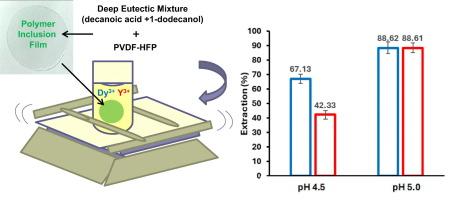含1-十二醇-癸酸共晶混合物的聚合物包合膜的研制,用于萃取Dy3+和Y3+
IF 5.1
3区 工程技术
Q1 CHEMISTRY, APPLIED
引用次数: 0
摘要
研究了以聚偏氟乙烯-共六氟丙烯为基体,癸酸(DA)为萃取剂,1-十二醇(DD)为改性剂的聚合物包合膜(PIF)对稀土离子Dy3+和Y3+的萃取作用。观察到DA和DD在室温下形成液体后,使用调温差示扫描量热法研究了该混合物的热性能。该二元体系的相图显示共晶组成约为70% (m/m) DD和30% (m/m) DA,包晶点约为40% (m/m) DD和60% (m/m) DA。还确定了DD:DA质量比在40:60 - 80:20范围内的组合物在20°C以上的温度下保持液态,从而使它们适合用作pif中的液相。在DD:DA质量比为20:40 ~ 40:20的情况下,在含60% (m/m)膜液相的pif中提取Dy3+的实验中,尽管萃取剂(DA)浓度有显著差异,但Dy3+的提取率没有显著差异。结果表明,pif对Dy3+的选择性萃取优于Y3+,表明上述pif对这些稀土离子的分离具有潜在的适用性。本文章由计算机程序翻译,如有差异,请以英文原文为准。

Development of a polymer inclusion film incorporating a 1-dodecanol–decanoic acid eutectic mixture for the extraction of Dy3+ and Y3+
The extraction of the rare earth element (REE) ions Dy3+ and Y3+ by a polymer inclusion film (PIF), composed of poly(vinylidene fluoride-co-hexafluoropropylene) as the base polymer, decanoic acid (DA) as the extractant and 1-dodecanol (DD) as a modifier, was investigated. After observing that combining DA and DD formed a liquid at room temperature, the thermal properties of this mixture were studied using temperature modulated differential scanning calorimetry. The phase diagram of this binary system showed a eutectic composition of approximately 70 %(m/m) DD and 30 %(m/m) DA and a peritectic point at approximately 40 %(m/m) DD and 60 %(m/m) DA. It was also established that compositions with mass ratios of DD:DA in the range 40:60 − 80:20 remained liquid at temperatures above 20 °C, thus making them suitable for use as liquid phases in PIFs. Extraction experiments of Dy3+ into PIFs containing 60 %(m/m) film liquid phase with mass ratios of DD:DA in the range 20:40 − 40:20 did not show significant differences in the rate of Dy3+ extraction despite the significant variation in the extractant (DA) concentration. Selective extraction of Dy3+ over Y3+ was demonstrated, indicating the potential applicability of the abovementioned PIFs for the separation of these REE ions.
求助全文
通过发布文献求助,成功后即可免费获取论文全文。
去求助
来源期刊

Reactive & Functional Polymers
工程技术-高分子科学
CiteScore
8.90
自引率
5.90%
发文量
259
审稿时长
27 days
期刊介绍:
Reactive & Functional Polymers provides a forum to disseminate original ideas, concepts and developments in the science and technology of polymers with functional groups, which impart specific chemical reactivity or physical, chemical, structural, biological, and pharmacological functionality. The scope covers organic polymers, acting for instance as reagents, catalysts, templates, ion-exchangers, selective sorbents, chelating or antimicrobial agents, drug carriers, sensors, membranes, and hydrogels. This also includes reactive cross-linkable prepolymers and high-performance thermosetting polymers, natural or degradable polymers, conducting polymers, and porous polymers.
Original research articles must contain thorough molecular and material characterization data on synthesis of the above polymers in combination with their applications. Applications include but are not limited to catalysis, water or effluent treatment, separations and recovery, electronics and information storage, energy conversion, encapsulation, or adhesion.
 求助内容:
求助内容: 应助结果提醒方式:
应助结果提醒方式:


